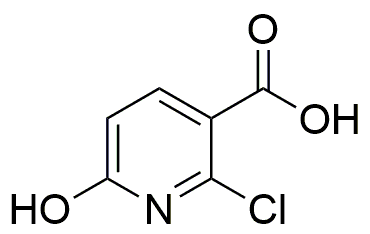2-Chloro-6-hydroxynicotinic acid is widely utilized in research focused on:
- Pharmaceutical Development: This compound serves as a key intermediate in the synthesis of various pharmaceuticals, particularly those targeting neurological disorders, enhancing drug efficacy and specificity.
- Agricultural Chemistry: It is used in the formulation of herbicides and pesticides, helping to improve crop yields by effectively managing weed populations while minimizing environmental impact.
- Biochemical Research: The compound is valuable in studies related to enzyme inhibition and receptor binding, providing insights into metabolic pathways and potential therapeutic targets.
- Analytical Chemistry: It acts as a standard reference material in chromatographic techniques, ensuring accurate quantification of similar compounds in complex mixtures.
- Material Science: This chemical is explored in the development of novel materials, such as polymers and coatings, which exhibit enhanced properties like durability and resistance to degradation.
Informations générales
Propriétés
Sécurité et réglementation
Applications
2-Chloro-6-hydroxynicotinic acid is widely utilized in research focused on:
- Pharmaceutical Development: This compound serves as a key intermediate in the synthesis of various pharmaceuticals, particularly those targeting neurological disorders, enhancing drug efficacy and specificity.
- Agricultural Chemistry: It is used in the formulation of herbicides and pesticides, helping to improve crop yields by effectively managing weed populations while minimizing environmental impact.
- Biochemical Research: The compound is valuable in studies related to enzyme inhibition and receptor binding, providing insights into metabolic pathways and potential therapeutic targets.
- Analytical Chemistry: It acts as a standard reference material in chromatographic techniques, ensuring accurate quantification of similar compounds in complex mixtures.
- Material Science: This chemical is explored in the development of novel materials, such as polymers and coatings, which exhibit enhanced properties like durability and resistance to degradation.
Documents
Fiches de données de sécurité (FDS)
La FDS fournit des informations de sécurité complètes sur la manipulation, le stockage et l’élimination du produit.
Spécifications du produit (PS)
Le PS fournit une description complète des propriétés du produit, notamment sa composition chimique, son état physique, sa pureté et les exigences de stockage. Il détaille également les plages de qualité acceptables et les applications prévues du produit.
Certificats d'analyse (COA)
Recherchez des certificats d'analyse (COA) en saisissant le numéro de lot du produit. Les numéros de lot et de lot se trouvent sur l'étiquette d'un produit, après les mots « Lot » ou « Lot de fabrication ».
Numéro de catalogue
Numéro de lot/série
Certificats d'origine (COO)
Ce certificat d'exploitation confirme le pays dans lequel le produit a été fabriqué, et détaille également les matériaux et composants utilisés et s'il est issu de sources naturelles, synthétiques ou autres sources spécifiques. Ce certificat peut être requis pour les douanes, le commerce et la conformité réglementaire.
Numéro de catalogue
Numéro de lot/série
Fiches de données de sécurité (FDS)
La FDS fournit des informations de sécurité complètes sur la manipulation, le stockage et l’élimination du produit.
DownloadSpécifications du produit (PS)
Le PS fournit une description complète des propriétés du produit, notamment sa composition chimique, son état physique, sa pureté et les exigences de stockage. Il détaille également les plages de qualité acceptables et les applications prévues du produit.
DownloadCertificats d'analyse (COA)
Recherchez des certificats d'analyse (COA) en saisissant le numéro de lot du produit. Les numéros de lot et de lot se trouvent sur l'étiquette d'un produit, après les mots « Lot » ou « Lot de fabrication ».
Numéro de catalogue
Numéro de lot/série
Certificats d'origine (COO)
Ce certificat d'exploitation confirme le pays dans lequel le produit a été fabriqué, et détaille également les matériaux et composants utilisés et s'il est issu de sources naturelles, synthétiques ou autres sources spécifiques. Ce certificat peut être requis pour les douanes, le commerce et la conformité réglementaire.


